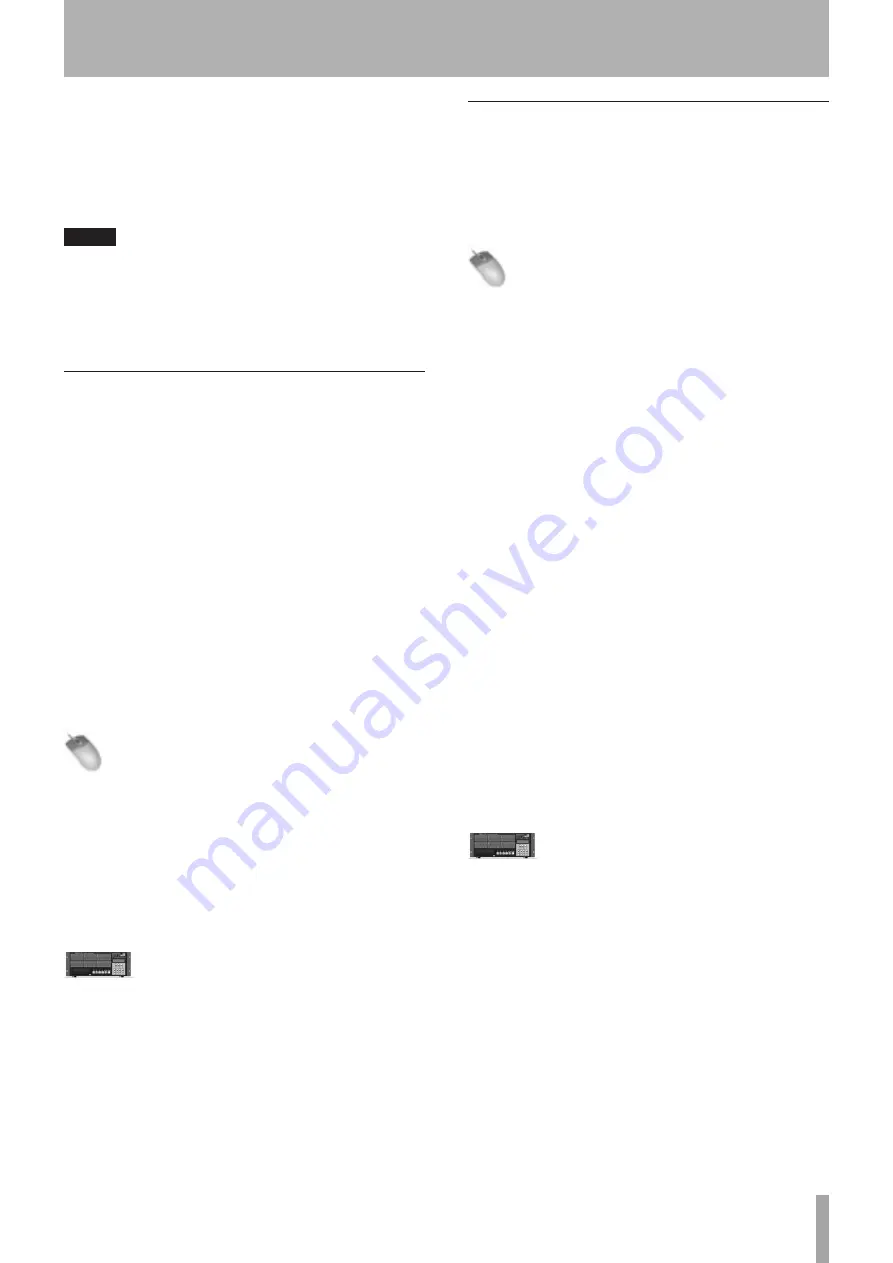
TASCAM X-48MKII
33
Marker Properties
screen (select from
Windows
menu)
and selecting
Loop
. You can also enter them directly
on this screen.
You can also capture loop points during loop
playback. Use the keyboard F key to set the start
point and the T key to set the stop point.
NOTE
The loop interval is not shown on the screen when the
loop function is off.
3 Press
Play
.
4 To disable the loop function, click the loop button
again.
Loop Mode
The X-48MKII has three Loop Modes:
Play Once and Cue
Play Once and Cue
plays through the loop once, then
locates to the beginning of the loop (or pre-roll point if
enabled) and stops.
Play Once and Stop
Play Once and Stop
plays through the loop once and then
stops at the loop end (or post-roll point if enabled).
Play Repeatedly
Play Repeatedly
plays through the loop, locates to the
beginning of the loop (or preroll point if enabled) and
plays again, repeating until the stop button is pressed.
By default, the Loop mode is set to
Play Once and Cue
. To
change this behavior:
Mouse/Keyboard Operation
1 Click on the
Windows
menu and choose
Settings
.
2 Select the
Transport
tab.
3 The submenu titled
Loop Mode
has the three choices
explained above.
You can also set the playback mode using the
LOOP
MODE
item on the
I/O MARKER Properties
screen (select
from the
Windows
menu).
Front Panel Operation
1 Press the PREF button. Press the
5
/
b
buttons
until you select
Loop Mode
and press CHNG.
2 Select one of the three choices explained above
and press Enter.
Auto Punch
The Auto Punch function automatically drops into and
out of record when switched on. This is used to automate
a difficult punch in and out, such as one word in a lead
vocal or an ADR (automated dialog replacement) line that
will be attempted several times.
Mouse/Keyboard Operation
1 First, set the punch in and punch out points. At the
default setting, the starting and ending points of
the last recording are automatically set as the in
and out points, respectively. You can disable this
automatic setting by opening the
Transport
tab of
the
SETTINGS
screen (select the
Settings
item from the
Windows
menu), and remove the check mark next to
the
Update Punch Points
item. )
You can also drag the punch in and out points in
the timeline ruler, they are the red triangles that
fill the timeline ruler. You may want to zoom into a
waveform and set the markers manually if you’re
trying to replace or spot-erase some recorded
audio.
In addition, you can also capture the current time
as the punch in or punch out point by opening
the
I/O Marker Properties
screen (select from
Windows
menu) and selecting
Punch
. You can also enter them
directly on this screen.
2 Hold the
Shift
button and click the
Record
button
on the onscreen transport to switch on
Auto Punch
mode. The
Record
light will flash.
3 Move the transport to a location before the punch-
in point and press
Play
. When the transport reaches
the punch-in point it will punch into record. When
it passes the punch-out point it will go into play
again.
Front Panel Operation
1 First, set the punch in and out points. By default,
the recorder remembers the last timecode that
you punched into and out of record and uses
these for your punch in and out points. (To change
this behavior, press the PREF button to open the
Preferences menu and use the
and
buttons to
select
Update Punch Points
and change that
setting to Off.) You can use the Rehearse button
to punch in and out of record without actually
recording to set new punch in and out points.
2 To enter
Auto Punch
mode, hold the SHIFT
button and press RECORD. The Record light
will flash.
3 Move the transport to a location before the punch-
in point and press PLAY. When the transport
reaches the punch-in point it will punch into
5 – Recorder






























